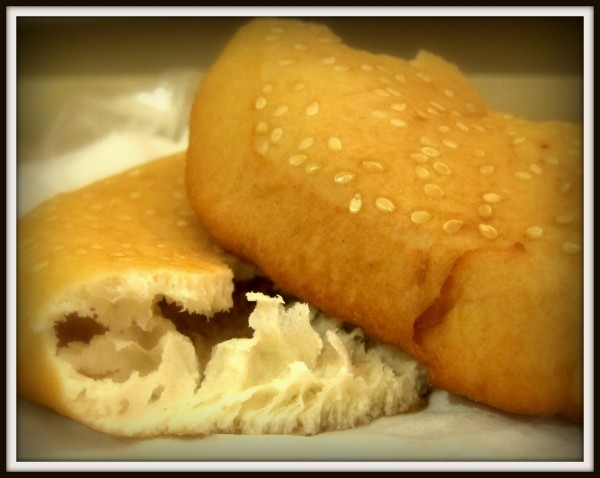 Little Mom and I… we just have different tastes. She likes seafood. She prefers crunchy to soft. She doesn’t like sticky rice (!) She thinks the mini sponge muffins (bánh bò bông, the Vietnamese kind) are sourer than the white chewy honeycombs (bánh bò, the Chinese kind). I beg to differ. The mini sponges can be eaten alone; the honeycombs are almost always stuffed inside a hollow fried doughnut that is more savory than sweet: their sourness needs to be suppressed by the natural saltiness of oil and the airy crunch of fried batter. That doughnut, brought to us by the Chinese and called by us “bánh tiêu“, saves the honeycombs. The honeycombs could go hang out with the dodo for all I care, but this Saigonese would always appreciate a well-fried bánh tiêu. At any time of the day, one would be able to spot a street cart with the signature double-shelf glass box next to a vat of dark yellow oil. The oil gets darkened from frying too many doughnuts too many times. Sure, it isn’t healthy. But should you really care about health when you eat fried dough? “Fried dough […]
Continue reading Sandwich Shop Goodies 19 – Bánh tiêu (Chinese sesame beignet)
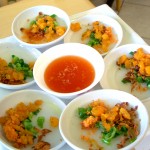 A couple of millimeters thin, chewy, savory, bánh bèo, the waterfern-shaped appetizer, is as familiar to the Vietnamese dining tables as crab cakes to Americans. But not everyone makes it at home because it takes more time than its worth: make the rice flour batter, steam the banh, make the toppings, mix the fish sauce. In fact, I’ve had homemade bánh bèo only once, and it was at my friend’s family restaurant. That said, there are skilled and dedicated grandmas who insist on making everything from scratch for the best bánh bèo. One of them is Mrs. Tự, and Little Mom happened to see one episode of her cooking show on TV last week. So below are some tips on bánh bèo from Mrs Tự, collected from the show Nghệ Thuật Nấu Ăn Bà Tự (The Cooking Arts of Mrs Tự) on Global TV Houston. 1. Texture: The thinner bánh bèo is the better bánh bèo. Of course, resilience is a must, it should not be as chewy as a mochi, but it should have enough strength to hold itself together as the eater picks it up with chopsticks. How to make a thin but resilient […]
Continue reading Bánh bèo tips from Mrs. Tự
 … with English subtitles. It’s no secret that I’ve been into tea recently, and the interest is going to last for a while. Just in time for my mini-presentation in the Korean class, the topic was open, and I chose tea. Vietnamese tea, to be precise. Neither my Korean is good enough nor my tea knowledge is broad enough to give a more detailed slideshow, but it’s a start. Both will come, in time. 🙂 The title of the slideshow is “Vietnamese Tea”. I have no idea how bad my Korean pronunciation is, so I’ll just pretend that I don’t sound all *that* bad. 😉 I can understand myself, with the subtitles. 😉 Continue reading Four-minute Vienamese tea talk, in Korean
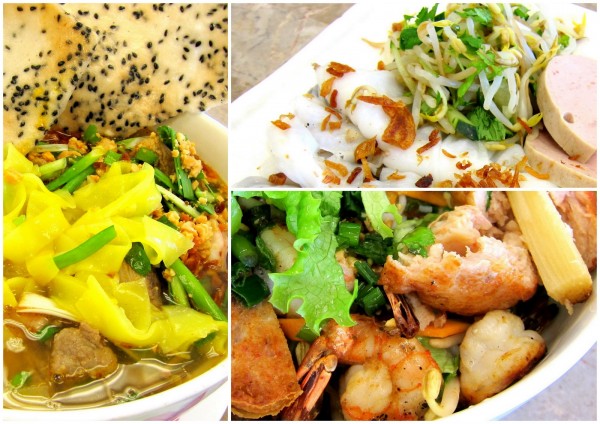 Like with most Asian eating establishments, it’s virtually impossible to answer the question “what is the best Vietnamese restaurant in [name of city]?” Let me stay there for about half a year, and I can tell you where to get the best pho, the best cha gio, the best bun thit nuong, the best banh mi, but not the best Vietnamese. Assuming you would agree that I can’t compare a place that specializes in noodle to another that specializes in beef, I would admit: I don’t know what you mean by “the best Vietnamese”. Do you mean everything on the menu is the best of its kind? Everything is good? Everything is cheap and good? Everything is cheap and good and the service is the best? Everything is cheap and good, the service is good, and the ambiance is the best? You see, there are more variables in your generic question than I could possibly control with my subjectivity. And that is not to consider the possibility of you asking that question just because I’m Vietnamese, which doesn’t bother me at all, but I’m usually not sure of how much detail you’d like to receive. (I’ve […]
Continue reading Bánh cuốn Hoa – The rule of the steamed rolls
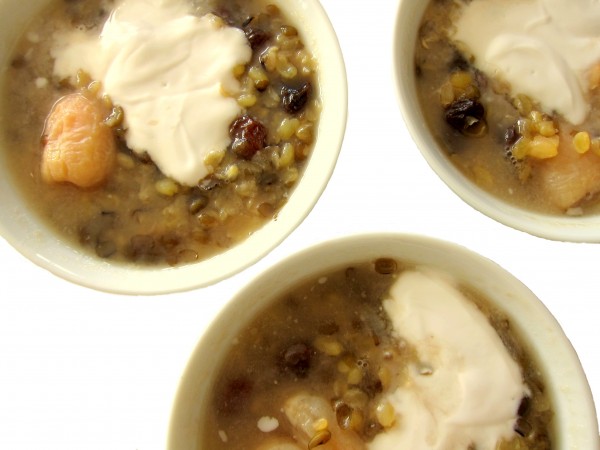 This dessert requires no skill in the making, but it ranks way up in the chè hierarchy, topping taro che and my own banana tapioca pudding. Beside the fact that Little Mom invented it, I always like things with lychee. 😉 Because everyone’s sweet tooth differs, it doesn’t make sense to have a fixed recipe for this simple dessert. One package of halved mung bean (with the green skin on), 1 can of whole lychee, 1 can of coconut milk, raisins, sugar and water are all there is to the pot. The mung bean need to be soaked in water overnight to soften and cook faster. The coconut milk and the syrup from the lychee can are mixed with water to cook the bean. More or less water depends on how thick you like your chè; the more liquidy chè served cold, which I prefer, is suitable as a palate cleanser after a big meal, and the thicker version is best as a midday snack. When the mixture boils and the bean becomes soft enough to dissolve in your mouth, add raisins and sugar to taste. Wait […]
Continue reading Lychee and mung bean che (Chè đậu xanh trái vải)
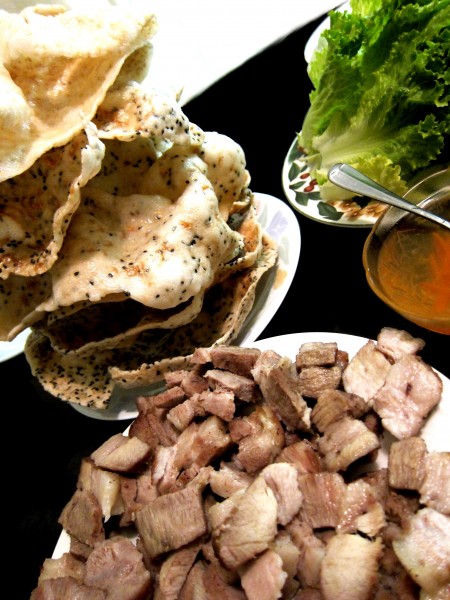 It’s the 29th of the 12th month in the lunar calendar. The last day of the Year of the Cat. The last day before Tet officially starts. But the preparation for Tet is also Tet. Having a good time is also Tet. Being home is also Tet. 🙂 One of the best parts of being home is not just getting to eat a lot. It’s getting to eat a lot of food that I would never have known otherwise. This time, Little Mom introduced me to the Central Vietnamese fun of a rice cracker roll. When I first heard the name, I thought I heard it wrong: how can you make a roll out of a stiff, crunchy, airy rice cracker (which we call a bánh tráng nướng in the South, or bánh đa in the North)? Simple. You dip it into water. Just like you would with the normal dry rice papers to make gỏi cuốn or chả giò. Except in this case, you get an extra thick roll with some crunch and air in the bite, and the nuttiness of thousands of sesame seeds ingrained in every bánh đa. The filling […]
Continue reading Central Vietnamese rice cracker roll (bánh đa cuốn thịt)
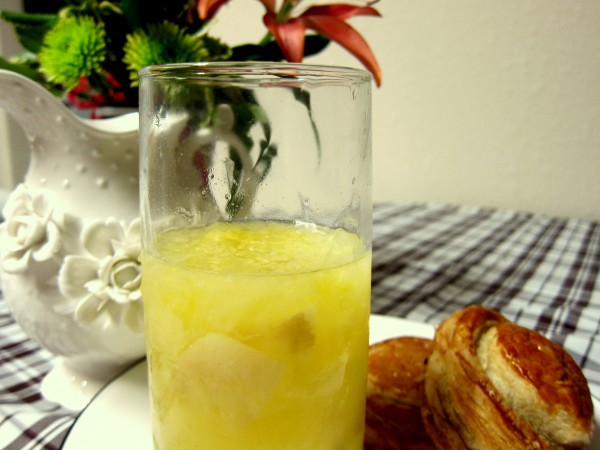 The triple punch from Little Mom: orange, lemon, and salted lime. Like instant ramen and popsicles, it all started from the leftovers: half a glass of a-little-too-salty salted lime drink, half a too-sour-to-eat orange, another half glass of normal lemonade (although Little Mom’s lemonade is not quite like any other lemonade, in a good way), and an ounce of reasoning. There was no sense in keeping them separately. The combined power shines a sweet yellow of tourmaline, smells like an orchard near the harvesting season, and tastes good enough to get me all poetically cheesy. Below is Little Mom’s recipe for the salted lime. As for the recipe of this “tricitronnade”, I would imagine that the orange doesn’t have to be sour. 😉 Continue reading Tricitronnade – Three-in-one Lemonade
 If you had to choose, what is the most Vietnamese dish? If you are a Vietnamese expat, what would make your mouth water the most just thinking about? What is the food, the smell, the taste that when you see or hear some stranger is savoring, you’d immediately think, “hey, he must be my fellow countryman”? One of my friends lives in Freiburg, Germany. There is one Vietnamese restaurant 1 km away from the University, der Reis-Garten, and it is the only Vietnamese restaurant in a 40-km radius (the next one is across the border: Le Bol d’Or in Wintzenheim, France). For over 6 years living away from home, he survived on pasta and tomato sauce, students don’t have time. One day, external circumstances have finally driven him to decide that he no longer needs to suppress his cravings out of consideration towards his Germanic housemates. He bought a bottle of fish sauce. The next day he made thịt kho. That makes it official: he’s Vietnamese, and he hasn’t forgotten it. “Success?” “Did you add coconut juice?” “Do you have eggs in the pot?” “Do you have chả lụa […]
Continue reading Year in, year out, savoring the savoriest of pork
 Vietnamese Something occurred to me within the last month: I probably should learn to pair drinks with food, but I hardly drink anything beside water and soymilk. Now I would *love* to learn about the different kinds of water, but living in the city makes it a bit difficult, and soymilk can’t be paired with everything like wine (yet). Coffee, alcoholic beverage, juice? Didn’t quite catch on. So what does that leave me? Tea. A quest takes form: Mai is going to learn tea. And Mai will cook with tea, too. Because boiling water to drink tea takes some work, I might as well make it worth a meal. How much influence the ochazuke at Mifune had on me, I’m not sure, but during the two minutes of wringling my brain out for some easy way to use tea in food, the first thing that came to mind was cooking rice with tea. Now that’s the difference between my tea rice and the ochazuke: my tea rice is rice cooked with tea, and the ochazuke is rice eaten with tea, like a soup. As with everything, there’s the easy way and the hard […]
Continue reading Black tea rice
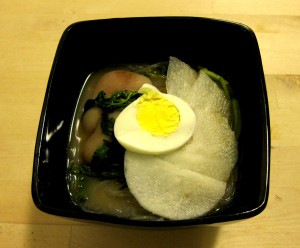 Sometimes my craziness surprises myself. I woke up one morning, reflecting that the week’s been warm, and decided to make mul naengmyeon (물 냉면). Weeks earlier, I bought the buckwheat noodles but never had the time to cook, or the mood. Now I still don’t have time to cook, but today is the day. I remember the main ingredients of a true Korean naengmyeon, but just to make sure that I don’t have them, I look at Maangchi’s recipe anyway. Beef bones? No. Mushroom? No. Dried anchovies? No. Kelp? No. Yeolmu kimchi juice? Hah. In my dreams. I don’t even have cucumber. Am I going to the store? Of course not. The wind might blow away my cooking mood, which is already rare as it is. Besides, I have a blind confidence that what I do have will make a fine bowl. The deaf ain’t scared by gun fires, they (we Vietnamese) say. Naengmyeon has three fundamental components: the broth, the buckwheat noodle, and the toppings. The broth needs to be clear and slender. To get the sweetness, I substitute beef bones by pig trotters. They have plenty of bones, and unfortunately […]
Continue reading Korean chilled noodle soup with a few Vietnamese twists
|
|
Blogs we read
|












